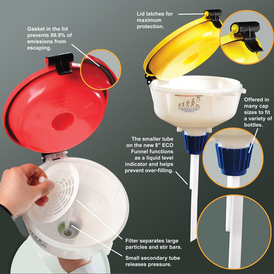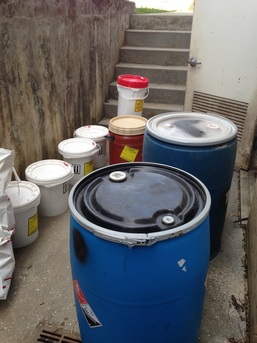Shepherd University is classified as a Conditionally Exempt Small Quantity Generator of hazardous waste by the United States Environmental Protection Agency, and as such has a responsibility to ensure that hazardous waste is properly managed from “cradle to grave.” Faculty members play an important role in the waste management process in the School of Natural Sciences and Mathematics. The role of those generating wastes within the School include:
- A waste determination (Is it a RCRA hazardous waste?);
- Selection of a compatible waste container;
- Waste collection;
- Proper labeling of the waste container.
Waste Determination
Waste Container Selection
Waste Collection
Waste Container Labeling
Waste Generation Tips
- Always segregate incompatible wastes.
- Avoid mixing hazardous waste with non-hazardous waste. The resulting mixture becomes a hazardous waste and will likely result in higher disposal costs.
- Collect waste in containers that match the anticipated volume of waste to be generated. (Do not collect 100 mL of waste in a 4 L container!)
- Do not overfill waste containers – at minimum, leave the necks of containers free of waste.
- Waste containers MUST always be closed, except when adding or removing waste. When using the Eco-Funnels, the lids must be closed after adding waste.
Note: All spills and contaminated materials (glassware, PPE, paper towels, etc.) should be managed appropriately. If unaddressed spills are observed in the lab, regulators may view these materials to be abandoned and/or inherently waste-like. All spills should be addressed immediately, no matter how minor, to prevent unnecessary risks to employees, students and visitors and to also avoid citations/fines.
ECO-Funnels In the Labs
In an effort to prevent RCRA violations from having open waste containers in SNS&M laboratories and unnecessary exposure to hazardous waste, ECO-Funnels have been introduced in some of the laboratories. ECO-Funnels not only help minimize open waste containers, they are a safer alternative to using an open funnel to collect waste. Additionally, they have a mesh screen to filter out larger solids from your waste streams.
Shepherd University has a “cradle to grave” responsibility for the waste that it generates. This means that the University is responsible for its waste from the time that the waste is generated until the time that the waste is disposed of by a RCRA-permitted Treatment, Storage and Disposal Facility (TSDF). This includes the time during which the waste is being transported. The “cradle to grave” process through which the University’s waste travels is described below.
As a Conditionally Exempt Small Quantity Generator, Shepherd University is limited to the quantity of hazardous waste it generates. Most of the waste generated in SNS&M laboratories is collected in containers that hold four liters of waste or less. The majority of these containers cannot be shipped to a TSDF without first being over-packed or “lab-packed.” A lab-pack will be performed to consolidate smaller waste containers into larger DOT certified containers/drums (see picture top right). These lab-packs are done by DOT/RCRA-trained professionals. Before the waste may be shipped off campus for ultimate disposal, a Uniform Hazardous Waste Manifest (see sample below) must be completed/reviewed and signed by a trained Shepherd University representative. The manifest is the official tracking document for the waste being shipped to the TSDF. The University representative must certify in Box 15 of the manifest that the contents of the shipment are “…fully and accurately described…and are, classified, packaged, marked and labeled/placarded, and are in all respects in proper condition for transport…” and that the University has made a “good faith effort” to minimize waste. The waste may be hauled to a RCRA-permitted storage facility temporarily prior to being transported to a TSDF. Once Shepherd’s waste has been received by the TSDF, the TSDF will have 45 days to return a copy of the manifest certifying receipt of the waste. It is the University’s responsibility to ensure that they receive a copy of the manifest from the TSDF within that time frame. (All copies of the Uniform Hazardous Waste Manifest must be retained for a minimum of three years.) After receiving the waste, the TSDF will have one year to store the University’s waste before the TSDF is required to dispose of the waste. After disposal is completed, the TSDF will typically provide a Certificate of Destruction to the University. Although a Certificate of Destruction is not required by law, it is in the best interest of the University to obtain one as it certifies that the University has fulfilled their “cradle to grave” management of their waste.

